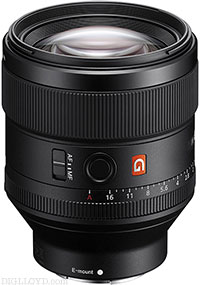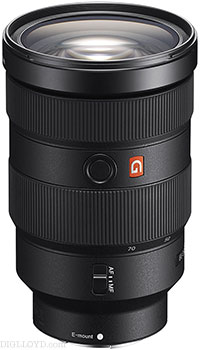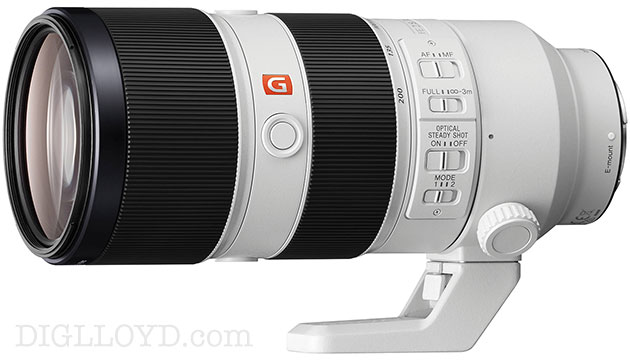Reader Comment: Big and Heavy Sony G Master Lenses
Get Sony G Master Lens at B&H Photo.
Howard C writes:
The new G Master lenses that Sony has announced seem like all good news. Sony is demonstrating a commitment to developing state of the art lenses at premium prices.
Here’s my concern. Sony appears to be segmenting its lens line into two groups of lenses. The G Master lenses will be big, heavy, fast and expensive lenses with the best optical quality. The other lenses will be smaller, lighter, slower and less expensive lenses, with good to very good optical quality but not at the level of the G Master line.
This is very unfortunate for me and many others who bought into the Sony A7R and A7RII cameras based upon the promise of exceptional performance in a compact form factor. We want smaller and lighter lenses that are the state of the art in optical performance and are willing to pay for them. We are also perfectly ok that the tradeoff is that these lenses would be f/2.8 or f/4 lenses.
I actually think that Sony is making a major blunder here in positioning its products. Sony is falling into trap of applying yesterday’s model of DSLR marketing: premium quality lenses at premium prices that have to be big and heavy because they are fast, and they have to be fast because that’s what “Pros” and wannabe “Pros” demand.
My sense is that there are far more photographers who have bought into the Sony A7 system who can afford and will buy very premium priced lenses if those lenses are smaller and lighter, and they couldn’t care less about an extra f stop.
I believe you share these sentiments, and it would be great if you could send that message to Sony loud and clear.
DIGLLOYD: I agree absolutely. See The Irrational Aim of f/1.4 Lenses. While I appreciate fast apertures for some purposes like wide aperture landscapes, hauling three Zeiss Otus (or Sony G Master) lenses up 3000' in elevation is a real drag. Ditto for hauling around through an airport, walking a city street for hours, etc.
The Zeiss Batis and Zeiss Loxia lenses are a size and weight that just about answer the above requirement (Loxia 21/2.8 is the best existence proof). I’d settle for 25/2.8 and 90/2.8, particularly if the quality were ramped up to Otus levels. However, the Batis line is really good as it stands.
Sony is definitely not thinking outside convention with its lens strategy. On the other hand, Sony is hitting the right checkboxes for head-to-head with CaNikon.
We can hope that Zeiss persists in expanding the Batis and Loxia lines, and that Sony eventually sees the need for f/2.8 super lenses. According to Sony Alpha Rumors, there is a Zeiss Batis 18mm f/2.8 on the way soon. So that would make the Batis 18/2.8, Loxia 21/2.8, Batis 25/2, Loxia 35/2 to cover the wide end in a quite small total size/weight package. Not the semi-Otus performance I’d like but well into excellent territory.
Here is what I’d like to see from Sony. These lenses should exceed the performance of Zeiss Batis and Zeiss Loxia and would be priced significantly higher for that reason:
- 15mm f/2.8 APO fisheye
- 18/3.5, 21/3.2, 25/2.8, 28/2.8, 35/2.8 (all APO)
- 50/2 APO, 90/2.8 APO, 135/3.4 APO, 180/4 APO
John N writes:
Howard C, 'gets it'. Sony and Zeiss don't.
Now all we need is a high quality and light 18 to 100 travel zoom for the A7 platform.
What a awesome combo that would be for the serious 'light weight' traveler.
Somehow it just seems to make sense. If you want to tool up with all the other lenses when weight and convenience are not such a major consideration then that is fine. I, however, am quite prepared to sacrifice a bit of quality for a whole lot more convenience.
DIGLLOYD: Zeiss absolutely 'gets it'; the Loxia lenses hit the nail on the head better than anything. And the Batis lenses are very friendly also.
If lower quality is acceptable, then Sony already nails it there too with their existing f/4 zooms. There will not be a high quality and light 18-100; this is not a reasonable expectation. But a 35-70mm f/3.4 should be feasible with advance optical approaches.
Dr S writes:
Yes Sony is probably making an error with their new lenses but how about this take? These days my "casual" camera bag consists of the Batis 25, Sony 35,1.4, and Sony 55 1.8...... all great lenses and luckily I have a good copy of the 35, 1.4. Granted they have a maximum aperture greater than 2.8 but if you take the weight of the 3 lenses into account it is more than the weight of one 24-70, 2,8 Sony G.
We could get into protracted discussions but if the IQ is of superior quality at all focal lengths in the new Sony 24-70 then one may pause,.take a moment in thought, and decide whether or not to take just one body/one lens so no lens changes are not necessary. Of course I like primes but I tested this hypothesis last weekend and took my Canon 24-70 II/Metabones adapter/A7rii out for a spin and I was very satisfied with the weight and the IQ of the photos was high. I'm just sayin'...
DIGLLOYD: I don’t think Sony is making any errors here other than the error of omission; the new G Master lenses pound the nail squarely for competing with CaNikon offerings. What the G Master lenses do not do is offer the promise of compact high performance on the Sony mirrorless platform.
Richard S writes:
These comments are spot on. Great performance is possible in a light compact package. We just did a 30x45 canvas wrap for a client made from a DSC-RX1 file and it was superb. Better than what I’d expect from a zoom, and resolution wise, almost as good as my Sigma 35mm art lens on a D810. It showed some chromatic aberration in the corners, but it was only evident on black branches on white snow. It is a good example of what is possible with a relatively compact lens. I really want a set of top quality primes that are light and in the f2.8-4 range as they would be what I would carry 90% of the time.
DIGLLOYD: This equation will only improve with time (sensor quality, full color sensors, perhaps curves sensors allowing higher quality lenses, etc). The question is whether interchangeable lens cameras will offer the equivalent (moderate speed compact very high quality lenses).
As I wrote 2.5 years ago in The Future of Image Quality is Fixed-Lens Cameras, moderate speed lenses matched to the sensor have huge potential as yet only modestly exploited by Sigma and by Sony and by Ricoh and Fujifilm and Nikon and Leica. Perhaps one of those companies will be daring enough to deliver a medium format fixed-lens camera.
James P writes:
Everyone thinks bigger is better, but in reality why is it that Leica can manufacture lenses that are so small compared to the same lens in Sony or for any other 35mm system? You could pack three Leica M lenses in the same space that just about any other lens takes up.
DIGLLOYD: the short answer is “hugely expensive and tradeoffs/compromises involved”. And it’s also just not true, as the Loxia line and the Sony 35/2.8 show. In fact, the Sony 35/2.8 is lighter than the Leica 28/2.8 Elmarit-M ASPH. Try on the Loxia 21/2.8 which is faster than the Leica M 21/3.4 and higher performance too.
The longer answer is that there are numerous compromises and tradeoffs. The assumption that M system is superior is generally, as my various comparisons have shown. Are there standouts? Of course—but this is true of Leica, Zeiss, Canon, Nikon, Sigma also.
- Leica M lenses are hugely expensive, even the cheapest models. And far from perfect; the quality control is not there. My 50/2 APO remains a disappointment (skew)—two copies, the first one seriously flawed (flare).
- All of the M lenses are for a rangefinder and many are compromised on digital (though newer designs are tweaked).
- No autofocus! The new Leica SL 50/1.4 (due out in a year or so) will NOT be a small lens. The Leica 24-90mm f/2.8-4 Vario-Elmarit-SL ASPH shows clearly that Leica has the same challenges as any other vendor.
- No close-focus ability!
- Compromised: pronounced field curvature in all of the Leica Summilux designs, quite strong secondary color including often hideous violet fringing, many of the designs have troublesome focus shift, nearly every model has problems with flare control.
- Consider the highest performing Leica M lens: it is $8000 and f/2 and its flare control is less good than many DSLR lenses, certainly nowhere as good as the Zeiss Otus 55/1.4 APO-Distagon.
- The 21/3.4 SEM and 24/3.8 designs are excellent, but these are ~f/4 designs! And they are still very expensive and the 21/3.4 has clear limits even at 24 megapixels.
- Let’s see the M designs hold up on a 50 megapixel sensor: then the serious limitations will stand out like a sore thumb. The SL lenses already show the limits.
In short, the Leica M lenses are not a good baseline for what is possible for DSLRs and/or mirrorless. My view is that at present, Sigma may be the only company today that could deliver a cost effective high performance f/2.8 - f/4 line of ultra high performance compact primes. Zeiss of course could work wonders, but the price would be quite high.

































